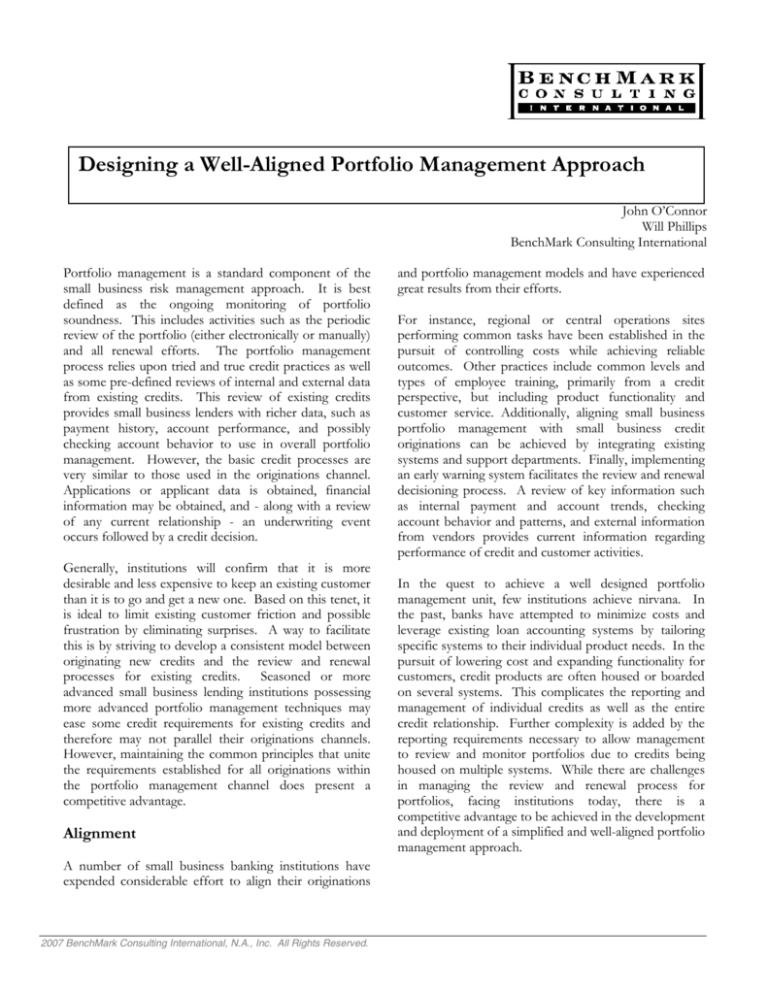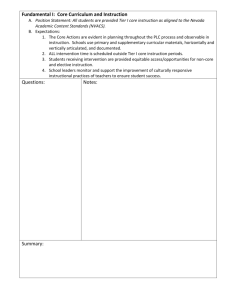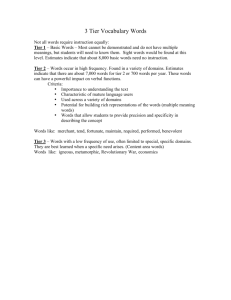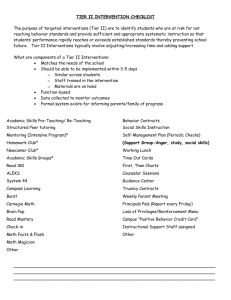
Designing a Well-Aligned Portfolio Management Approach
John O’Connor
Will Phillips
BenchMark Consulting International
Portfolio management is a standard component of the
small business risk management approach. It is best
defined as the ongoing monitoring of portfolio
soundness. This includes activities such as the periodic
review of the portfolio (either electronically or manually)
and all renewal efforts. The portfolio management
process relies upon tried and true credit practices as well
as some pre-defined reviews of internal and external data
from existing credits. This review of existing credits
provides small business lenders with richer data, such as
payment history, account performance, and possibly
checking account behavior to use in overall portfolio
management. However, the basic credit processes are
very similar to those used in the originations channel.
Applications or applicant data is obtained, financial
information may be obtained, and - along with a review
of any current relationship - an underwriting event
occurs followed by a credit decision.
Generally, institutions will confirm that it is more
desirable and less expensive to keep an existing customer
than it is to go and get a new one. Based on this tenet, it
is ideal to limit existing customer friction and possible
frustration by eliminating surprises. A way to facilitate
this is by striving to develop a consistent model between
originating new credits and the review and renewal
processes for existing credits. Seasoned or more
advanced small business lending institutions possessing
more advanced portfolio management techniques may
ease some credit requirements for existing credits and
therefore may not parallel their originations channels.
However, maintaining the common principles that unite
the requirements established for all originations within
the portfolio management channel does present a
competitive advantage.
Alignment
A number of small business banking institutions have
expended considerable effort to align their originations
2007 BenchMark Consulting International, N.A., Inc. All Rights Reserved.
and portfolio management models and have experienced
great results from their efforts.
For instance, regional or central operations sites
performing common tasks have been established in the
pursuit of controlling costs while achieving reliable
outcomes. Other practices include common levels and
types of employee training, primarily from a credit
perspective, but including product functionality and
customer service. Additionally, aligning small business
portfolio management with small business credit
originations can be achieved by integrating existing
systems and support departments. Finally, implementing
an early warning system facilitates the review and renewal
decisioning process. A review of key information such
as internal payment and account trends, checking
account behavior and patterns, and external information
from vendors provides current information regarding
performance of credit and customer activities.
In the quest to achieve a well designed portfolio
management unit, few institutions achieve nirvana. In
the past, banks have attempted to minimize costs and
leverage existing loan accounting systems by tailoring
specific systems to their individual product needs. In the
pursuit of lowering cost and expanding functionality for
customers, credit products are often housed or boarded
on several systems. This complicates the reporting and
management of individual credits as well as the entire
credit relationship. Further complexity is added by the
reporting requirements necessary to allow management
to review and monitor portfolios due to credits being
housed on multiple systems. While there are challenges
in managing the review and renewal process for
portfolios, facing institutions today, there is a
competitive advantage to be achieved in the development
and deployment of a simplified and well-aligned portfolio
management approach.
Unit Design
The design of the small business portfolio management
unit may take on many shapes, roles and functions.
However, the primary role should be that of performing
the review and renewal of existing credits and ultimately
determining the overall soundness of the portfolio. The
review process may consist of a systematic review or
early warning system (EWS) as well as a more traditional
review processes. Both approaches may review similar
information such as credit repayment trends and account
histories. The EWS approach reviews predetermined
account characteristics on a regular basis such as
quarterly, monthly, or even daily – but it is expensive.
The traditional review process is labor intensive and may
only be performed on an annual, quarterly or in some
cases monthly basis. The EWS process consists of
evaluating internal data from borrower(s) and
guarantor(s). Information such as credit trends and
repayment histories as well as checking accounts inflow
and outflows are reviewed. External payment and credit
data obtained from various vendors is blended into the
analysis to produce a comprehensive view of the
relationship.
This systematic evaluation process assesses payment and
credit behaviors that ultimately determine the propensity
for debt repayment.
Systematically reviewing the
payment histories and behavior characteristics of a
borrower and guarantor can present compelling
information about how payments will be made on a
credit in the future. Eliminating the manual processes
performed in the traditional review of credits allows for
significantly more credits to be evaluated with greater
regularity and reduced costs.
The traditional review process is deployed at predefined
times as established through the loan agreement as well
as when “exceptions” occur from the output or results
from the EWS. Traditional reviews occur when required
by covenants or when collateral or financial data indicate
that a close watch is required to monitor credit
performance. EWS exceptions may occur when a key
review characteristic fails predetermined limits or exceeds
specific thresholds. These exceptions result in a failed
EWS review and require manual intervention by a
portfolio manager. Therefore, the deployment of an
EWS should not be viewed as a replacement of the
traditional review process but as a facilitator of the
review process.
Ideally, striving to develop an EWS with the goal of
alignment with the originations channels may yield
considerable benefits. This design might typically be
patterned after the example in Figure I.
Example of a Well-Aligned Portfolio Management Approach
Tier
I
Tier
II
Tier
III
Origination Credit
Tier
Score Only
No Financials
Score Plus
(Score + Key Ratios)
1 Years Financials
Traditional (Financial
data supported)
1 Years Financials
Review Technique
Exceptions
(Failed Reviews)
Review for
Mitigators
100% of portfolio on a
Monthly, Quarterly, and Annual
basis
Failed Tier I reviews. Consists
Review for
of internal data combined with
Mitigators
3-8 key financial ratios
Failed Tier II reviews. Consists Review for
of complete spreading of
Mitigators
financial information
Early Warning Technology
BenchMark Consulting International
Refer to Tier III
Exit / Work out
Figure I
For the purposes of this illustration, there are 3 levels or tiers.
Failed
Mitigators
Refer to Tier II
Early Warning Technology
Early Warning Technology
Early Warning Technology
Credit Tier I or Score only (No Financials)
Credit Tier II or Score Plus (1 Year of Financials)
Credit Tier III or Traditional (1 Year of Financials)
2
Designing a Portfolio Management Approach –June 2007
this channel rely upon a combination of score with some
key financial ratios from the borrower(s) and guarantor(s)
based on a single year of financial information from each.
Relying on a blend of key information that does not
require a comprehensive analysis of financial information
streamlines the information gathering and decisioning
process. Tier II or Score Plus Key Ratios are utilized at
the tier following the Score Only Tier and may reach to
$250M or even $500M. Some institutions may rely on
only two channels such as the score only and traditional
tiers in the review and renewal process. However,
considerable upside potential exists in implementing a
mid-tier review process.
Tier I or Score Only
The score only tier exists in a large number of small
business banking institutions today. Credit decisions
are made on applicants utilizing an automated system
that relies on application data and an off-the-shelf
credit scoring application or a customized scorecard.
Decisions are made based on key data from the
borrower (business) and usually the guarantor (owner)
typically in the absence of financial statements or full
tax returns. Generally, these loan applications range in
the $50M - $100M and may or may not be unsecured.
In the score only tier (from a portfolio management
perspective), a systematic review based upon scores
from the borrower and guarantor is performed and
managed on an exception basis. Typically, all credits
from the entire small business portfolio stream through
this channel and may be systematically reviewed on a
monthly, quarterly or semi-annual basis. Reviewing
credit information on a regular basis allows institutions
to evaluate risk based upon empirical data and
determine if additional steps should be taken to
mitigate these risks.
Exceptions in the Tier II or Score Plus tier may also occur
due to negative trends or irregularities observed either in
scores or financial data. As in the Score Only or Tier I
segment, this may require an escalation to the next level, or
Tier III. This tier is the final segment of review and
renewal and is traditional credit evaluation.
This may
require 1 year of financial information if the outcome of
the Tier II review results in a higher-than-acceptable risk
assessment. As in the exception process with Tier I Score
Only, actions such as continuance of the existing terms,
modification, closure, or a transfer may be warranted.
While each institution should review policies and
procedures, evaluation of current payment histories
from borrowers and guarantors tend to be valuable
indicators of overall payment histories.
Tier III or Traditional
Tier III or Traditional Process is based on the institution’s
traditional form of credit analysis from an originations
perspective with a blend of internal payment history and
account performance review. This tier also may be
required if covenants, benchmarks, or more complex
collateral structures are part of the original decision
process and required in the Loan Agreement. Decisions in
this channel rely primarily on the comprehensive financial
analysis performed on 1 year of financial information.
Exceptions exist from time to time and when a
systematic review exhibits negative trend(s) or
irregularities, the appropriate steps need to be taken to
mitigate these risks. Depending on the exception
occurring in Tier I and whether there are acceptable
mitigators, a credit may require a Tier II evaluation.
This requires obtaining additional information from the
borrower and/or guarantor. A single year of financial
information may be obtained to determine if there are
negative financial trends, increased expenses or other
inhibitors that are impacting payment performance.
Evaluating this information may result in a number of
actions based on the severity of the situation. These
actions may include a continuance of existing terms, a
modification of terms, closing the existing facility or
transferring the request to another specialized unit for
final disposition.
Tier III or Traditional Process succeeds the Tier II Score
Plus process and, based on the example, would begin
where Tier II ends at $250M or $500M (or as high as
$750M, for some) or where exceptions require a complete
analysis.
The primary focus of each level or tier of processes is to
focus attention on the critical areas required to review or
renew a credit and to mitigate any current or evolving
risks. While multiple variations of the tiers may exist, the
key areas such as score only, score with minimal financial
information, and traditional analysis should encompass the
entire portfolio management needs. More importantly, the
information review requirements should parallel the
originations channel.
Tier II or Score Plus
Tier II or Score Plus may mirror the originations channel
from a dollar segment basis and may or may not exist
in some small business institutions today. Decisions in
BenchMark Consulting International
3
Designing a Portfolio Management Approach –June 2007
The design in Figure I is one that, in many cases,
mirrors the originations design or methodologies
utilized to underwrite new credit requests. Institutions
utilizing credit scoring in the originations channel
should gain significant knowledge from credit scoring
and leverage this knowledge in developing a portfolio
management model. Blending this information with
internal
payment
criteria,
account
behavior
performance, and depository account behavior
evaluation provide the critical information required in
the review and renewal phase. Some small business
lenders may implement less stringent requirements on
the underwriting of existing credits due to the extent of
internal payment information available and if the
performance of the credit and customer fall within
acceptable ranges.
functionality while minimizing costs, institutions have
utilized many different loan accounting systems to board
credits. A multitude of loan accounting systems may exist
in banks that are involved in the mortgage, home equity,
consumer, credit card and commercial banking segments.
Loan accounting systems have been developed and
tailored with the functionality to serve a specific loan type.
Lending to small businesses tends to encompass all of
these areas. This results in loans to small businesses being
booked or housed on multiple systems, complicating the
management of each credit and, therefore, the entire credit
relationship. Any number of challenges may arise such as
different customer service departments providing servicing
to an individual loan; lack of common loan statements;
inability to combine loans into a single loan or a combined
loan statement; lines of credit that require a phone call to
access vs. other lines of credit that are card access; etc.
These examples provide some convincing evidence that a
competitive advantage is achieved by aligning the
originations model with the portfolio management model.
While it is entirely possible that portfolio management
techniques advance to a point where less and less
information is required to review and renew requests,
more or additional information above that requested for a
new credit is a recipe for frustration. Establishing
common methodologies for decisioning and customer
service activities is crucial to the positive customer
experience that institutions seek.
Leveraging the information obtained from credit
scoring deployed in the originations channel combined
with internally generated data presents a rich source of
information on payment and behavior. Behavior of the
borrower and guarantor ultimately determines whether
payments are made or not made on small business
credits. Obtaining and utilizing this information should
serve as the foundation of a true early warning system
(EWS). An EWS can review a credit as often as
annually, monthly, or daily and therefore provide
immediate feedback on the performance of a credit. A
comprehensive portfolio management strategy should
involve the deployment of an EWS in some form. This
provides an overall view of the entire credit cycle from
origination to review and renewal. Criteria utilized to
decision the original credit is leveraged and
incorporated into the re-decisioning of the existing
credit. In summary, it is critical that a portfolio
management approach be developed based upon the
lessons and experiences gained from credit scoring in
the originations channel.
Benefits
The benefits to be achieved from a well-aligned portfolio
management and originations process can be significant.
Employee’s credit skill development is just one area where
positive results are achieved from a well-aligned process.
Many institutions may segment the originations credit
decisioning from the portfolio management credit
decisioning due to the time-sensitive nature of new credit
requests. Credit employees from both segments require
similar education, training and background. Aligning these
segments allows for the greater likelihood of achieving
consistent decisions. Whether the request is for a new
loan or the review or renewal of an existing credit, a
consistent decisioning practice is essential. This results in
the need for a common basic training and education
program to be implemented in order for employees to
develop similar skills. Other benefits such as potentially
leveraging employees’ skills from one segment to another
to broaden experience levels only enriches the overall
performance and satisfaction levels of employees. Also,
fluctuations in volume of either channel may be met with
the re-allocation of staff from one segment to another.
Customer support and assistance training is simplified and
Challenges
The many challenges of establishing and extending the
usefulness of a well aligned portfolio management unit
are common across most institutions. Creating a
functional design for portfolio management relies upon
many attributes working in concert. Establishing an
environment where credit policies and people are
aligned to perform well and present customers with
consistent decisions presents many obstacles. These
obstacles do not end after the credit origination process
has been completed.
In an all-out effort to provide customers with product
BenchMark Consulting International
4
Designing a Portfolio Management Approach –June 2007
aligned with common credit information which ensures
the same responses to customer questions.
experience (even with a potentially negative outcome) can
ultimately lead to positive results.
Customers also benefit when institutions implement
well-aligned originations and portfolio management
units. For example, requests for financial information
should be consistent at all dollar levels and mirror,
where possible, that which is requested for new credits.
The likelihood of consistent decisions is greater and
therefore more reliable results are achieved from a
credit perspective. This produces a positive outcome
for customers and minimizes any potential scrutiny
from compliance and regulatory departments. With
customer support aligned with the originations and
portfolio management channels, customers receive
common feedback, results, messages, and guidance. A
common message communicated to customers
minimizes frustration and establishes credibility across
the entire banking institution. Enhancing the customer
Summary
BenchMark Consulting International
There are significant benefits to be gained in the creation
and implementation of a well-aligned portfolio
management model.
Incorporating products and
processes layered with realistic credit policies can enhance
the portfolio management model for both employees and
customers. Developing a cohesive model with originations
also provides considerable advantages from a customer
perspective. Consistency in decisions from a credit
standpoint and common customer service and support
departments are vital to minimizing customer frustration
and defection. Finally, establishing an aligned portfolio
management model along with the originations model can
provide significant upside results for the small banking
institution as well as the customers.
5
Designing a Portfolio Management Approach –June 2007
John O’Connor is the Commercial Lending Practice Manager responsible for the sale and delivery of commercial
banking engagements. He holds extensive experience in commercial banking management, reengineering and
streamlining operations, product and project management, mergers and consolidations.
(j-oconnor@benchmarkinternational.com)
Will Phillips is a consultant at BenchMark Consulting International with extensive experience in the financial services
industry. He specializes in commercial, small business, middle market, and consumer lending. During his successful
career in the industry, Will has worked in a variety of functional areas and roles at leading financial institutions including
underwriting; credit; loan documentation; customer service; and process improvement.
(w-phillips@benchmarkinternational.com)
BenchMark Consulting International has specialized in improving the financial services industry since 1988. The
company is a management consulting firm that improves the profitability of its financial services customers through the
delivery of management decision-making information and change management services to realize the benefits of
business process changes. BenchMark Consulting International’s expertise is in the measuring, designing, and managing
of operational processes.
The firm has worked with 39 of the top 50 (in asset size) commercial banks, all 14 automobile captive finance
corporations, several of the largest consumer finance corporations and many regional and community banks throughout
the United States. Internationally, BenchMark Consulting International has worked with the five largest Canadian
commercial banks, more than 40 European organizations in 11 different countries, in addition to financial institutions
in Latin America, Australia and Asia.
The company is a wholly owned subsidiary of Fidelity National Information Services, Inc., with clients in more than 50
countries and territories providing application software, information processing management, outsourcing services and
professional IT consulting to the financial services and mortgage industries. BenchMark Consulting International has
dual headquarters in Atlanta, Georgia and Munich, Germany.
For more information please visit www.benchmarkinternational.com.
BenchMark Consulting International
14 Piedmont Center NE, Suite 950
Atlanta, GA 30305
(404) 442-4100
www.benchmarkinternational.com









